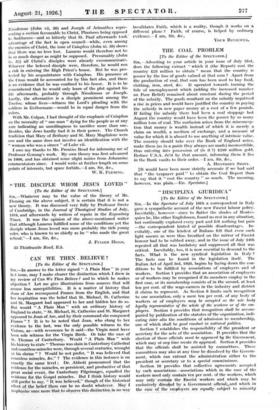WHO WROTE 11:1/. FOURTH GOSPEL?
[To the Editor of the SPECTATOiL] , •
•
Sin,—With regard to the theory of the authorship Of 04 Fourth 'Gospel which appeared in your columns above my name,' may I endeavour to reply to the very courteous ktters Of Mr. C. POyntz Sanderson, Mr. F. Prentiss Read, and Mr. W. H. Colgan?
I have always recognized that John xii, 10 is the chief difficulty in the actual record. Ginsiderations of space forbade in)27 dealing with it, as with soine-other details. Mir answer would be : There were, notoriously, parties' in the Sanhedrin). Nicodemus (John vii, 50) and Joseph of Arimathea repre- senting-a section favourable to Christ, Pharisees being opposed to Sadducees—and so bitterly that St. Paul afterwards took' advantage of the fact in open council—while, even among the enemies of Christ, the tone of Caiaphas (John xi. 49) shows that there was no love lost. Lazarus would therefore not bc in so much danger as might be supposed. Presumably (John ix. 52) all Christ's disciples were already excommunicate. Whoever the beloved disciple were, therefore, he would run a risk in entering the High Priest's house. But he was pro- tected by his acquaintance with Caiaphas. His presence at the Cross would be accounted for by this fact also, and there is no evidence that he was confined to his house. It is to be remembered that he would only learn of the plot against his life afterwards, probably through Nicodemus or Joseph. Lastly, the alternative is a disciple prominent among the Twelve,- whose lives—witness the Lord's pleading with the soldiers in Gethsemane—would be in equal danger from the rulers.
With Mr. Colgan, I had thought of the emphasis of Caiaphas on the necessity of" one man" dying for the people as at any rate indicating an unwillingness to sacrifice more than one. Besides, the Jews hardly had it in their power: The Church tradition that Mary of Bethany and St. Mary Magdalene were one and the same does not involve an identification with the woman who was a sinner" of Luke vii.
I owe my thanks to Mr. Prentiss Read for informing me of
Professor Genung's work. My own theory was first advanced in 1906, and has obtained some slight notice from Johannine commentators since. I would write at further length on some points of interests, but space forbicts.—I am, Sir, &c., W. K. FLE3IING.



































 Previous page
Previous page